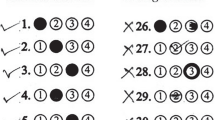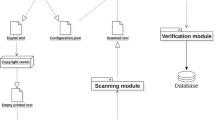Abstract
In spite of the high accuracy of the existing optical mark reading (OMR) systems and devices, a few restrictions remain existent. In this work, we aim to reduce the restrictions of multiple-choice questions (MCQ) within tests. We use an image registration technique to extract the answer boxes from answer sheets. Unlike other systems that rely on simple image processing steps to recognize the extracted answer boxes, we address the problem from another perspective by training a machine learning classifier to recognize the class of each answer box (i.e., confirmed, crossed out or blank answer). This gives us the ability to deal with a variety of shading and mark patterns, and distinguish between chosen (i.e., confirmed) and canceled answers (i.e., crossed out). All existing machine learning techniques require a large number of examples in order to train a model for classification; therefore, we present a dataset including six real MCQ assessments with different answer sheet templates. We evaluate two strategies of classification: a straightforward approach and a two-stage classifier approach. We test two handcrafted feature methods and a convolutional neural network. At the end, we present an easy-to-use graphical user interface of the proposed system. Compared with existing OMR systems, the proposed system has the least constraints and achieves a high accuracy. We believe that the presented work will further direct the development of OMR systems toward reducing the restrictions of the MCQ tests.









Similar content being viewed by others
Notes
(1) MCTest Corrector. (2) ZipGrade. (3) MCScanner. (4) Exam Reader (ER).
References
Gronlund, N.E.: Assessment of student achievement. ERIC (1998)
McCoubrie, P.: Improving the fairness of multiple-choice questions: a literature review. Med. Teach. 26(8), 709–712 (2004)
Aldabe, I., Maritxalar, M.: Semantic similarity measures for the generation of science tests in basque. IEEE Trans. Learn. Technol. 7(4), 375–387 (2014)
Liu, M., Rus, V., Liu, L.: Automatic chinese multiple choice question generation using mixed similarity strategy. IEEE Trans. Learn. Technol. 11(2), 193–202 (2017)
Spadaccini, A., Rizzo, V.: A multiple-choice test recognition system based on the Gamera framework (2011). arXiv preprint arXiv:1105.3834
Chai, D.: Automated marking of printed multiple choice answer sheets. In: IEEE International Conference on Teaching, Assessment, and Learning for Engineering (TALE), pp. 145–149 (2016)
Fisteus, J.A., Pardo, A., García, N.F.: Grading multiple choice exams with low-cost and portable computer–vision techniques. J. Sci. Educ. Technol. 22(4), 560–571 (2013)
Ahmed, A.H, Afifi, M., Korashy, M., William, E.K, El-sattar, M.A., Hafez, Z.: OCR system for poor quality images using chain–code representation. In: The 1st International Conference on Advanced Intelligent System and Informatics, pp. 151–161 (2016)
Wang, T., Wu, D.J, Coates, A., Ng, A.Y: End-to-end text recognition with convolutional neural networks. In: 21st International Conference on Pattern Recognition (ICPR), pp. 3304–3308 (2012)
Jaderberg, M., Simonyan, K., Vedaldi, A., Zisserman, A.: Reading text in the wild with convolutional neural networks. Int. J. Comput. Vis. 116(1), 1–20 (2016)
Chinnasarn, K., Rangsanseri, Y.: An image-processing oriented optical mark reader. J. Soc. Photo Opt. Instrum. Eng. 3808, 702–709 (1999)
Nguyen, T.D., Manh, Q.H., Minh, P.B., Thanh, L.N., Hoang, T.M.: Efficient and reliable camera based multiple-choice test grading system. In: International Conference on Advanced Technologies for Communications (ATC), pp. 268–271 (2011)
Hussmann, S., Deng, P.W.: A high-speed optical mark reader hardware implementation at low cost using programmable logic. Real Time Imaging 11(1), 19–30 (2005)
Deng, H., Wang, F., Liang, B.: A low-cost OMR solution for educational applications. In: International Symposium on Parallel and Distributed Processing with Applications, pp. 967–970 (2008)
Levi, J.A., Solewicz, Y.A., Dvir, Y., Steinberg, Y.: Method of verifying declared identity in optical answer sheets. Soft Comput. 15(3), 461–468 (2011)
Chouvatut, V., Prathan, S.: The flexible and adaptive x-mark detection for the simple answer sheets. In: International Computer Science and Engineering Conference (ICSEC), pp. 433–439 (2014)
van der Maaten, L., Hinton, G.: Visualizing data using t-SNE. J. Mach. Learn. Res. 9, 2579–2605 (2008)
Otsu, N.: A threshold selection method from gray-level histograms. IEEE Trans. Syst. Man Cybern. 9(1), 62–66 (1979)
Lopresti, D., Nagy, G., Smith, E.B.: A document analysis system for supporting electronic voting research. In: The Eighth IAPR International Workshop on Document Analysis Systems, pp. 167–174 (2008)
Barney-Smith, E.H., Nagy, G., Lopresti, D.: Mark detection from scanned ballots. In: Document Recognition and Retrieval XVI, vol. 7247, pp. 72470P-1–72470P-10 (2009)
Smith, E.H.B., Lopresti, D., Nagy, G., Wu, Z.: Towards improved paper-based election technology. In: International Conference on Document Analysis and Recognition (ICDAR), pp. 1255–1259 (2011)
Nagy, G., Lopresti, Dv: The role of document image analysis in trustworthy elections. In: Advances in Digital Document Processing and Retrieval, pp. 51–81 (2014)
Smith, A.M: Optical mark reading-making it easy for users. In: Proceedings of the 9th annual ACM SIGUCCS conference on User services, pp. 257–263 (1981)
Lopresti, D., Nagy, G., Smith, E.B.: A document analysis system for supporting electronic voting research. In: The Eighth International Workshop on Document Analysis Systems, pp. 167–174 (2008)
Sanguansat, P.: Robust and low-cost optical mark recognition for automated data entry. In: International Conference on Electrical Engineering/Electronics, Computer, Telecommunications and Information Technology (ECTI-CON), pp. 1–5 (2015)
China, R.T., de Assis Zampirolli, F., de Oliveira Neves, R.P., Quilici-Gonzalez, J.A.: An application for automatic multiple-choice test grading on android. Rev. Bras. Iniciaç. Cient. 3(2), 4–25 (2016)
Bay, H., Tuytelaars, T., Van Gool, L.: Surf: Speeded up robust features. In :ECCV, pp. 404–417 (2006)
Muja, M., Lowe, D.G: Fast matching of binary features. In: Ninth Conference on Computer and Robot Vision (CRV), pp. 404–410 (2012)
Torr, P.H.S., Murray, D.W.: The development and comparison of robust methods for estimating the fundamental matrix. Int. J. Comput. Vis. 24(3), 271–300 (1997)
Lewis, D.D: Naive (Bayes) at forty: the independence assumption in information retrieval. In: European Conference on Machine Learning, pp. 4–15 (1998)
Csurka, G., Dance, C., Fan, L., Willamowski, J., Bray, C.: Visual categorization with bags of keypoints. In: Workshop on Statistical Learning in Computer Vision, ECCV, pp. 1–2 (2004)
Krizhevsky, A., Sutskever, I., Hinton, G.E: Imagenet classification with deep convolutional neural networks. In: Advances in Neural Information Processing Systems, pp. 1097–1105 (2012)
Dalal, N., Triggs, B.: Histograms of oriented gradients for human detection. In: CVPR, pp. 886–893 (2005)
Vapnik, V.N., Vapnik, V.: Statistical Learning Theory. Wiley, New York (1998)
Mikolajczyk, K., Schmid, C.: An affine invariant interest point detector. In: ECCV, pp. 128–142 (2002)
Duda, R.O., Hart, P.E., Stork, D.G.: Pattern Classification. Wiley, New York (2012)
LeCun, Y., Bengio, Y., Hinton, G.: Deep learning. Nature 521(7553), 436–444 (2015)
Simonyan, K., Zisserman, A.: Very deep convolutional networks for large-scale image recognition (2014). arXiv preprint arXiv:1409.1556
He, K., Zhang, X., Ren, S., Sun, J.: Deep residual learning for image recognition. In: CVPR, pp. 770–778 (2016)
Canziani, A., Paszke, A., Culurciello, E.: An analysis of deep neural network models for practical applications (2016). arXiv preprint arXiv:1605.07678
Murphy, K.P.: Machine Learning: A Probabilistic Perspective. MIT Press, Cambridge (2012)
Storkey, A.: When training and test sets are different: characterizing learning transfer. In: Quiñonero-Candela, J., Sugiyama, M., Schwaighofer, A., Lawrence N.D. (eds.) Dataset Shift in Machine Learning, The MIT Press (2009)
Author information
Authors and Affiliations
Corresponding author
Additional information
Publisher's Note
Springer Nature remains neutral with regard to jurisdictional claims in published maps and institutional affiliations.
Rights and permissions
About this article
Cite this article
Afifi, M., Hussain, K.F. The achievement of higher flexibility in multiple-choice-based tests using image classification techniques. IJDAR 22, 127–142 (2019). https://doi.org/10.1007/s10032-019-00322-3
Received:
Revised:
Accepted:
Published:
Issue Date:
DOI: https://doi.org/10.1007/s10032-019-00322-3




